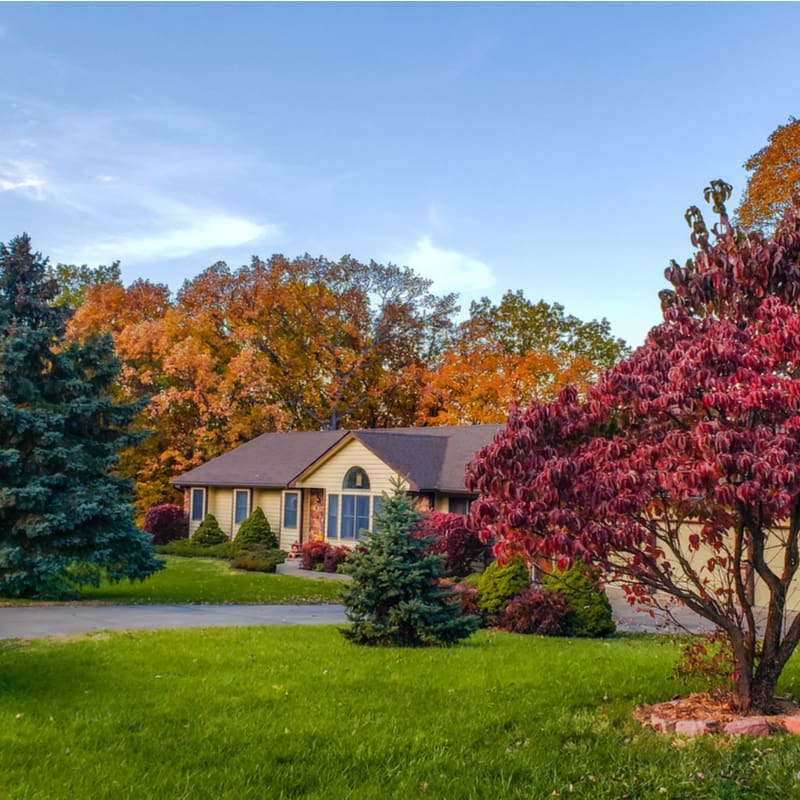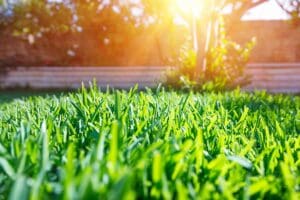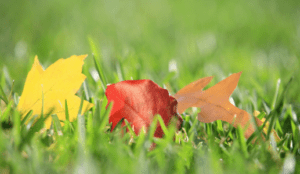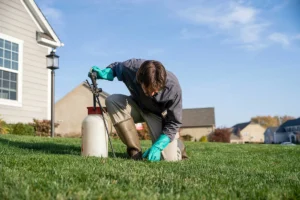Fall is perhaps the best time to be a Michigander. Our signature apples are in season and being pressed into delicious cider. College football is starting up. The unrelenting humidity of summer is traded for pleasant hoodie weather. There’s one thing that may not come to mind at this time of year, but it’s an essential thing to remember: fall tree and shrub care. What you do – or don’t do – can have a major impact on the health of your largest plants. If you want to keep your ornamentals looking pristine when spring comes, you’ll need to care for them before the cold season fully sets in.
How To Get Trees And Shrubs Prepared For Fall In Michigan
1. Make Sure Your Plants Have Enough Food
Traditionally, fall was time to celebrate the harvest. It was a time when humans would bring in crops from the fields and store them up to last throughout the winter. Trees are like people in this regard. Now’s the time when they will begin to store up their own nutrients so they, too, can make it through the coldest part of the year. To make sure they have enough nutrients, make sure to give them fertilizer through deep-root feeding. Deep-root feedings, also known as deep-root injections, deliver targeted nutrients directly to the tree’s root zone. This ensures that only the tree or shrub gets the food – not dormant weeds or nearby turfgrass. Using a specialized tool that resembles a medical syringe, your tree and shrub care services technician will inject fertilizer into the tree; in the same way, your doctor might give you a shot of B-vitamins.
Deep-root fertilization is vital for trees in more urban or developed areas. They are faced with higher stress conditions like low moisture, physical damage, construction, and pollution. When trees don’t have enough food, they are more likely to contract diseases or develop pest infestations. And when you throw the extreme cold of a Michigan winter on top of their low food stores, it’s a recipe for disaster. You can easily avoid this with a deep-root fertilization application.
2. Use Mulch To Manage Moisture
Mulching around a tree’s roots can help maintain good moisture levels during the coldest part of the year. Make sure to leave a six-inch gap between the base of the tree and the ring of mulch. You’ll want the mulch to be 2 – 3 inches deep and extend 2 – 3 feet around the trunk. Any layer of mulch that is deeper than 3 inches is just overkill. In fact, too much mulch can encourage a pest infestation since many bugs need dark, dank environments for shelter. Additionally, fungi, molds, and mildew love the same moist, dark environments, so having an overly thick layer of mulch could also invite microscopic pests. If you need to replace the old mulch, rake it up and bag it. Don’t pour new mulch on top of the old. If your tree or shrub is young, avoid using wood chips for your choice of mulch. Wood chips have a higher acidity than other mulch forms, which can harm younger trees since they aren’t as established within the soil.
3. Prevent Winterburn
Trees can not only lose moisture through the roots but also their branches and leaves. The dry, frigid air and high winds of winter can accelerate moisture loss, leaving trees with dead or dying branches. This is especially true for evergreens. They need their needles to thrive all winter, but if they experience winterburn, the needles will turn brown and fall off. This phenomenon is called winterburn or desiccation. The easiest way to combat this is with an anti-desiccant spray.
Anti-desiccants coat the trees in a protective wax coating, which reduces the amount of moisture lost through the leaves. It’s not unlike applying lip balm to prevent your lips from becoming dry and chapped in the winter. While nothing is 100% guaranteed in life, anti-desiccant can greatly reduce the number of brown spots you see on your evergreens. This is best applied to the trees in late autumn, as close to winter as possible.
4. Keep Wintering Insects Away
Like humans, insects will seek shelter during the coldest parts of the year. Unfortunately, that shelter may be your trees and shrubs! By applying a dormant oil application, you can kill any bugs on your plants. What’s great about dormant oil is that it will knock out bugs no matter which part of the life cycle they’re currently in – eggs, larvae, adults. These oils, also called horticulture oils, are perfectly safe for your plants – by the way. So you don’t need to worry about harming your trees in the process of wiping out annoying bugs.
5. Prune Dead Or Dying Branches
Depending on the size of your tree, dead or dying branches could pose a major risk to the health and safety of you, your family, or your property. Larger branches are especially bad to have over homes, garages, or driveways. If it looks diseased, damage, or outright dead, it’s best to remove it. If the branch looks healthy, but it’s still quite large, consider having it cabled. This process attaches a large, industrial-strength cable and secures it to the trunk of the tree. So if a severe storm or other problem breaks that branch off, it will not fall onto your property.
6. Now’s The Time To Plant New Trees
Michigan’s fall is the ideal time to plant new trees. The days are warm but not hot, and the nights are cool but not freezing. Planting new trees in summer can leave them parched and scorched. If you’re not sure which tree would be ideal for your yard, don’t hesitate to ask your Top Lawn technician! The last thing you want is to spend your hard-earned money on a tree or shrub that isn’t well-suited to your yard.
Get Professional Tree And Shrub Care Near West Bloomfield
If you want your ornamental plants to thrive next spring, now’s the time to prepare them for the cold season. For 20 years, the experts at Top Lawn have provided thousands of homes across metro Detroit with organic lawn care, tree and shrub care, and pest control services. Our multi-step tree and shrub care program offers your plants everything they need, from deep-root feeding to protective sprays. To learn more about how we can help your trees or schedule an appointment, give us a call at (248) 956-6022, or you can reach us online via our contact form. Be sure to check out our blog page next month for more information on all things related to trees, turfgrass, and pest control! You can also connect with us on Facebook and Twitter to see photos of our work and check out the latest deals and service offerings.





